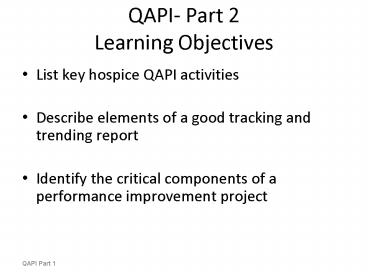QAPI Part 2 Learning Objectives - PowerPoint PPT Presentation
1 / 14
Title:
QAPI Part 2 Learning Objectives
Description:
Describe elements of a good tracking and trending report ... Dyspnea. Mild. None. Mild. QAPI Part 1. National Average 82% QAPI Part 1. Hospice-level example: ... – PowerPoint PPT presentation
Number of Views:362
Avg rating:3.0/5.0
Title: QAPI Part 2 Learning Objectives
1
QAPI- Part 2Learning Objectives
- List key hospice QAPI activities
- Describe elements of a good tracking and trending
report - Identify the critical components of a performance
improvement project
2
QAPI Activities
- Quality Assessment
- Collect quality data across both clinical and
non-clinical operational
areas - Use data to track quality measures over time
- Monitor of quality indicators at regular
intervals - Performance Improvement
- Use industry benchmarks and/or internal targets
(and patient-identified goals at the
patient-level) to identify opportunties to
improve - Take action when performance falls below target
for two periods or more - Implement performance improvement projects as
needed
3
Selecting Measures
- Have a plan or framework for quality measurement
- Clinical quality
- Non-clinical operations
- Have a rationale for each measure
- Why are you tracking?
- What will you do with the information?
- Consider using industry-vetted measures
4
Hospice Data Sources for QAPI
- Patient charts
- Incident reports
- Infection reports
- Satisfaction surveys
- Billing Records
- Human resources files
- Financial Reports
- Volunteer Records
5
Important Points About Data Collection
- Incorporate data collection for QAPI into
existing processes and procedures - Example Patient elements incorporated into
assessments and/or care plan - SYSTEMATIC Collect the same way every time
- Process measures are a good way to start
- Frequency of data collection
- Approved by governing body
- Based on timeframe that indicator is expected to
change
6
Using the Data - Actionable Reporting
- Graphs or tables
- Track and trend over time
- Relative to a benchmark or target
7
Identify Opportunities for Improvement When to
take action
- Quality assessment indicates a gap between
actual and desired performance - Survey deficiencies
- Management want to improve
- Staff suggestions
8
What action to take
- Individual patient
- Change interventions
- Revisit goal
- Continue to monitor
- Hospice-level
- Investigate causes
- Consider a Performance Improvement Project (PIP)
- Assure that improvement is sustained
9
PIP Overview
- Conducted by a team
- Include all relevant disciplines
- Different people for each project
- Designed to
- Investigate the reasons for the current level of
performance - Determine the best way to improve performance
- Measure improvements and assure they are sustained
10
Performance Improvement Projects
- Appoint a PIP team
- Investigate causes of current outcomes or
performance - Develop and implement plan for improvement
- Pilot testing with small of cases or limited
time - Document the project activities and results
11
Abbreviated PIP How they work
- Smaller team
- Review literature or best practice information
- Write a plan for improving performance
- Implement the plan
- Monitor results for one month (or two)
- Tweak the process if necessary and continue to
monitor
12
Pt.-level example Symptom Management
- Collect symptom severity data on each assessment
- Collect patient goal
- Monitor severity over time and relative to the
goal - Adjust interventions to reach goal and/or assist
patient in refining the goal
Patient Goal 3
13
Hospice-level example Aggregated clinical data
National Average 82
14
Hospice-level example Non-clinical operations































